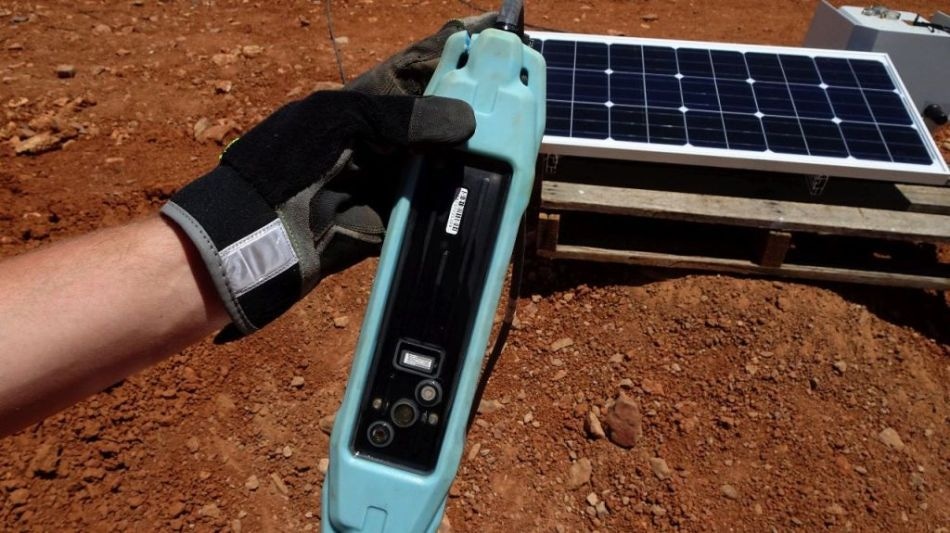Nov 22 2019
World-first trials of CSIRO’s automated sensor system, SENSEI, are providing promising, real-time results to better monitor and manage groundwater impacts in mining operations.
 SENSEI’s multi-sensor array can be embedded long-term within groundwater wells and aquifers and has been shown to deliver continual data for 12 months.
SENSEI’s multi-sensor array can be embedded long-term within groundwater wells and aquifers and has been shown to deliver continual data for 12 months.
CSIRO’s new automated groundwater monitoring system, called SENSEI, is a year into its world-first trial at Heathgate Resources’ Four Mile West uranium mine, some 550 kilometres north of Adelaide in South Australia.
Heathgate’s commitment to developing and operating Four Mile West as a world’s best-practice in-situ recovery (ISR) mine provided an ideal opportunity to trial SENSEI technology in a challenging environment.
ISR mining involves injecting alkaline or acidic fluids with an oxidant within a permeable geological formation, typically an aquifer. During this process, it is essential that the mining fluids are contained within the mining zone, as they are not only resource rich, but also have the potential to adversely affect adjacent areas, particularly aquifers.
Groundwater monitoring is an essential part of regulatory compliance. Conventionally, as is the case at the Beverley, Beverley North and Four Mile mining operations, this is done by manually pumping groundwater samples from each of a series of wells on the perimeter, overlying and underlying the mining area. The samples are then analysed to ensure that no mining fluid has drifted outside the immediate mining zone, laterally or vertically, and has been safely contained in the mining aquifer.
The manual sampling process at the mine typically takes two operators a month to complete, with analysis adding another time lag, so it can be two to eight weeks before the results are known. If anomalies are detected, the time between incident and action risks complicating the remediation process.
The value and benefits of SENSEI are evident. SENSEI solid-state sensors inserted into the wells can provide real-time, continuous data on pH, redox potential, conductivity, temperature and water level.
Results from the SENSEI system, that comprises the sensors and associated software, can be monitored onsite or remotely via the cloud.
With support from NERA and Boss Resources, the SENSEI trials at the Four Mile West mine began in November 2018 and, according to CSIRO project manager, Daniella Caruso, are progressing well.
“At the moment, we’re in the middle of phase one of the trial, in which ten sensors were deployed in the inner region of the lateral environmental monitoring wells,” Ms Caruso says.
“By collecting data and matching it with the manually derived results, we’ve learned most of the SENSEI architecture is working well after ten months in the field.”
“A major benefit of the field trials is that we’ve learned which components are working well and identified others that need optimising for underground water monitoring conditions.
“All the above-ground infrastructure is performing well, in conditions ranging from sub-zero nights to near 50-degree day time maximum temperatures.
“While our revolutionary sensor materials are performing well, we’re continuing to improve some components through the trial to optimise their performance under field conditions to have a longer lifespan.
“The results so far indicate excellent progress towards validation of the materials and construction of the SENSEI system for this application.”
According to Ms Caruso, achieving twelve months in the field is a big step forward, particularly because the underground components are exposed to 15 to 18 bars of pressure as the monitoring well-depths range from 150 to 180 metres. The trial is proving that SENSEI will result in miners increasing their operational efficiency with autonomous real-time access to accurate data.
Next steps for the trial involve optimising components, continuing to check results against the manual testing.
Before SENSEI can fully replace manual testing, the users and the government regulators must be satisfied that it meets rigorous groundwater monitoring requirements.
Then the benefits of lower-cost, real-time monitoring and remote access can be realised.
For CSIRO’s SENSEI team, this will be the first step in the journey that will potentially involve applications in other areas of the mining, water and allied industries.
“We’re thankful to Heathgate Resources, National Energy Resources Australia and Boss Resources for their sponsorship and support in providing the opportunity to field test SENSEI technology,” Ms Caruso says.
The CSIRO team is now looking for partners to bring the technology to market.